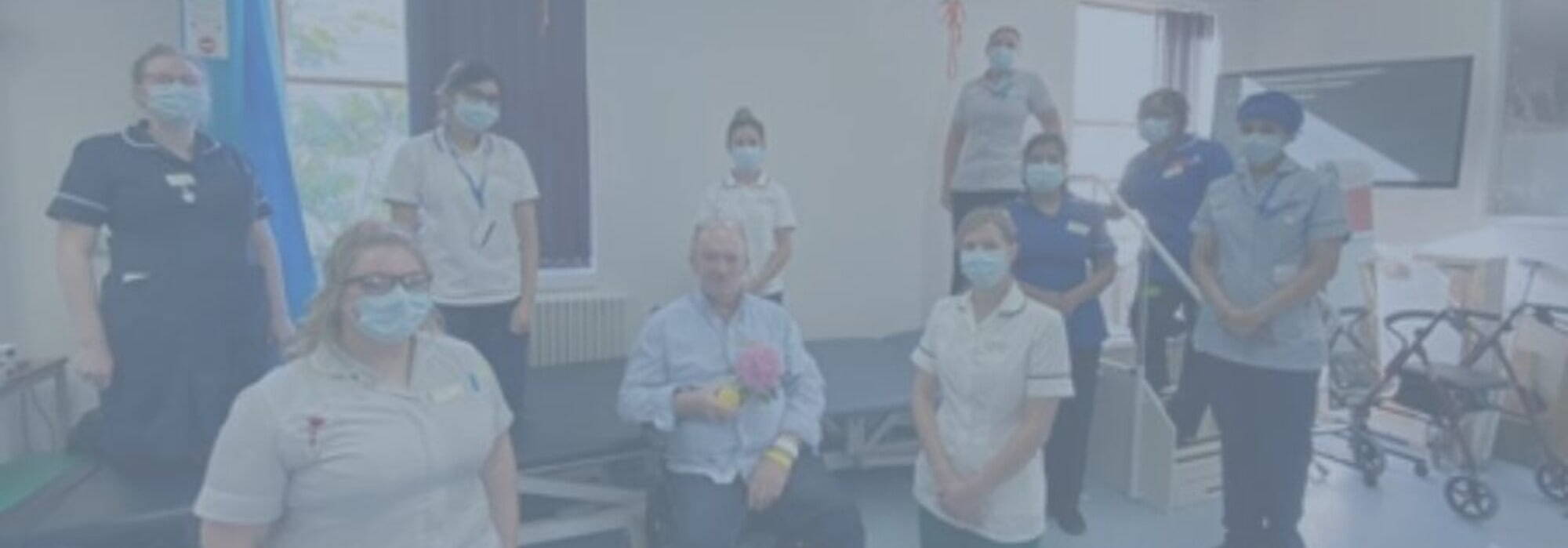Ward 7 - Hyper Acute Stroke Unit (HASU)
Ward 7 is a 24-bedded ward specialising in caring for patients following a stroke. We have a multi-disciplinary team that consists of many professions. We all work together to ensure the best outcomes for our patients. The senior team consists of:
• Senior Sister: Alexandra Stock
• Ward Sisters: Josephine, Robinah, Carla, Supriya and Sini
• We have three specialist stroke consultants: Dr Duodu and Dr Behnam, Dr Costa
• Specialist Stroke Nurse: Nina
• Lead physiotherapist: Nicola
• Lead occupational therapist: Kenya
• Matron: Caroline Harrison
Shift times:
Early Shift 07:00-15:0030 mins break
Late Shift 12:00-20:0030 mins break
Long Day 07:00-20:0060 mins break
Ward Visiting times
12:00-20:00 every day
Protected mealtimes
This means during mealtimes we try to ensure that there is the least disruption to our patient’s eating. Nutrition is a vital part of recovery and ensuring we give our patients protected time to eat a meal is vital.
Lunch 12:00-12:30
Dinner 17:00-17:30
Typical Day Routine
• 07:00- Handover from night staff to day staff
• 07:30-08:00- Ensure all patients have had breakfast and offer assistance where needed. Staff nurses begin medication round
• 08:30- Nurse in charge or Senior Sister attends daily ‘Huddle’. All patients are assisted or encouraged to have a wash
• 09:00- Nurse in charge and senior sister attend board round with therapy team and Doctors
• 10:00-11:00 Staff have a morning break. Patient’s observations are checked. Dr’s start their rounds and see every patient
• 11:00-12:00 Check patient’s blood sugars prior to meal times, ensure patients are ready for lunch. Therapy team will be working with patients
• 12:00-12:30 Lunch is served, some patients may need assistance. Staff Nurses begin their medication rounds
• 14:00-17:00 Patient’s observations are checked. Staff take an afternoon break
• 17:00-17:30 Dinner time
• 18:00-19:00 Staff Nurses complete medication round
• 19:30 Handover to night staff
This is an outline of a daily routine however patients can be unpredictable, and things change quickly. Throughout the day we enable our patients with toileting, hydration and mobilising. We must be reactive to patient’s needs. We are always planning towards discharge. The team respond to patients who may become unwell and need escalating.
Night time Routine
• 19:30 receive handover from day shift
• 20:00-22:00 Assist patients to get ready for bed. Check observations, blood sugars and offer toileting
• 22:00-23:00 Staff nurses complete medication round
• 06:00 Observations checked, patients assisted with toileting and BM’s checked. Any IV drugs administered. Breakfast served
• 07:00 Handover to day shift
Information on Stroke
What is it?
Stroke is caused by a disturbance to blood supply to the brain. It is one of the leading causes of morbidity in the UK. Over 152,000 people experience a stroke each year, causing weakness, and paralysis only 20% do not have weakness. Up to 75% people will have cognitive impairment there are two main types.
• ISCHAEMIC Is most commonly caused by a clot or extensive plaque built up a blockage of artery walls (embolic or thrombotic).
• INTRACEREBRAL HAEMORRHAGE (ICH) bleeding within the brain
• TRANSSSIENT ISCHEMIC ATTACK(TIA)Warning of stroke symptoms resolves within 24 hours.
• Subarachnoid Haemorrhage (SAH) – Bleeding into the subarachnoid space. It may be due to rupture of an aneurysm, extension of an intracerebral bleed or trauma.
• Subdural Haematoma- a collection of blood in the subdural space. It is associated with trauma e.g. road traffic accident NOT A STROKE but we may get these patients on our ward.
Investigations After Stroke
The purpose for investigation in both Stroke and TIA is to confirm clinical diagnosis, distinguish between haemorrhage and thromboembolic infarction and to look for underlying causes disease and to direct therapy, either medical or surgical.
• CT- Computer Tomography will demonstrate haemorrhage immediately (a diagnostic technique with the use of a computer and a machine emitting X-rays which produces cross section of the body tissues.)
• CAROTID DOPLER- (ultrasound studies in screening for arterial stenosis and occlusion.
• MRI - Magnetic resonance imaging (it produces a cross sectional or three dimensional images of organs and other body structures)
Treatments:
Ischaemic stroke – if within 4.5 hours of onset can be assessed for thrombolysis treatment, this has to be decided by a stroke consultant only and weighted up against the risk factors and give in a time critical manner – in MKUH this is done in ED between the hours of 8am – 5pm. Outside of this time patients will be taken to L&D hospital.
Within 6 hours large vessel ischaemic strokes may also benefit from thrombectomy – removal of clot (this is performed in Oxford university hospital). If > than 4.5 hours then an antiplatlet will be prescribed commonly aspirin and/ or clopidogrel. Other medication will be prescribed to aid an environment for reducing the penumbra injury. Please see appendix 1, 2 and 3.
Haemorrhagic Stroke: Blood pressure management please see appendix 4.
OUH is our neurosurgical centre and can be referred for clot removal. Appropriate drugs may be prescribed such as for hypertension, heart disease, diabetes, or other medical conditions. Antiplatelet agents, such as Dipyridamole if keeping this part remove dipyridamole as have not seen this in a very long time, Aspirin, Clopidogrel
Stroke – Causes & Risk Factors
Strokes can affect any age group, including children, but some are more likely than other to suffer a stroke, 25% of stroke are under 65 years old. Certain risk factors are some illness and medical conditions increase the risk of stroke. They include:
• High blood pressure – persistent, untreated hypertension is the major risk factor for stroke and transient ischemic attack (TIA).
• Cardiovascular problems – existing blood vessel disease, angina, heart attack, or a previous TIA, and atrial fibrillation (irregular heart beat) increase the risk of stroke.
• Diabetes – Doubles the risk of stroke
Some risk factors are beyond an individual’s control and can’t be treated. They include:
• Age – stroke is more common in people over age of 65.
• Gender - in under 75s men are more likely than women to have a stroke.
• Ethnic back ground - South Asians, Africans and African –Caribbean’s are at higher risk of stroke.
Each type of stroke has different causes. They include:
• Diseased arteries – blockage of an artery is usually as a result of atherosclerosis, furring and narrowing of the artery walls with a mixture of cholesterol and other debris.
• Aneurysm – a weakened spot on an artery wall causes it to stretch. The vessel wall may become so thin it burst causing bleeding into the brain. (Haemorrhagic stroke).
• Atrial fibrillation -this kind of irregular heartbeat (arrhythmia) can cause a blood clot to form in the heart, which then travels to the brain
LIFE STYLE RISKS
• Smoking – increases the risk of 6-8 times, furs up the arteries
• Diet – excessive calories and high fat and salt intake
• Hypertension – related to atherosclerosis and ruptured aneurysm
• Heart disease – atria, valves, ventricles
• Diabetes – doubles the risk linked with hypertension andatherosclerosis
• High alcohol intake – 5 times the risk & raised blood pressure
• Lack of physical exercise
• History of T.I.A’S – Increases the risk 5 times
• Contraceptive pills – makes blood more sticky and risk hypertension
• Age -blood vessels become less elastic
• Family history – possibly linked with other risk factors
• Ethnic group – Afro Caribbean’s are more likely to have hypertension, South Asians are more likely to develop diabetes
Complications Of Stroke
Communication
Aphasia/Dysphasia is a condition that is caused when the left side of the brain is damaged (which houses the communication centre that is responsible for speech, writing, reading and comprehension. Some people make mistakes in words they use, like using wrong sounds of words, and putting them together. Find it difficult to understand word sentences they hear or read. Expressive or/and receptive.
Dysarthriais when speech is affected by involvement of the muscle on the lips and tongue.
Dysphagiais the difficulty in swallowing.
Deep vein Thrombosis and Pulmonary Emboli usually occurs in the paretic vein of the leg and its common with advancing age due to the loss of muscle pump action and changes in the blood clotting factors. We do not use dalterparin on the stroke unit we can only use IPC’s.
Depression - can be caused by the brain- damaged tissue or psychological upset resulting in mood swings that are exaggerated. They can have feeling of hopelessness, loss of confidence, reduced motivation for rehabilitation, poor appetite, self-neglect, body image.
Epilepsy –Scar tissues can form around the stroke site and this can lead to increased electrical activity across the brain. Irritation from the scaring can be associated with abnormal electric changes and if these occur in a number of brain cells then the seizure may occur.
Hemianopia - this is a loss of vision in the corresponding halves of each eye’s field of vision.
Hemiplegia - Half body sided paralysis, is the left side of the brain is affected then there is a right sided weakness.
Incontinence/Urinary Tract Infection UTI- incontinence can be both in urine and faeces. UTI can be caused due to poor urinary flow, dehydration, or catheterisation.
Perceptual Loss Agnosia is the inability to recognise objects, pictures.
Apraxia is the difficulty in planning and executing the sequence of movement to achieve a task such as eating, washing, dressing etc.
Personality Changes the stroke patient may experience a total change of personality or certain aspects of their personality may become over exaggerated.
Pressure Sore this is Decubitus ulceration caused by coetaneous and sub coetaneous ischemia due to shearing, poor handling or repositioning.
Respiratory Infections these are mainly aspiration or hypostatic pneumonia caused by aspiration of food, drink, medication or accumulation of saliva. Inactivity can also lead to respiratory depression, inefficient coughing or chest movement.
Spasm Common features of hemiplegia and is caused by muscles contracting involuntarily in purposeless manner, this is called a spastic paralysis. These spasm affects the distal muscle group and flexors maximally and will be exacerbated by painful lesions including joints
Sensory Loss this is when an individual is unable to feel where one side of the hand or leg positioned without looking one sided neglect sensory loss and sensory neglect are two different things. Unable to feel pain or heat sensation.
Further Reading
Click the links below to find out more useful information:
• https://www.rcplondon.ac.uk/guidelines-policy/stroke-guidelines
• https://www.stroke.org.uk/sites/default/files/state_of_the_nation_2018.pdf
• https://www.strokeaudit.org/
Follow this link to return to the Ward Information Page.
















